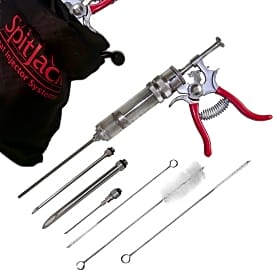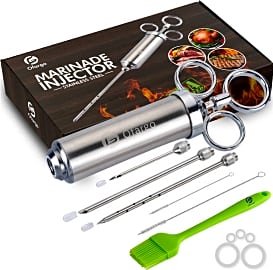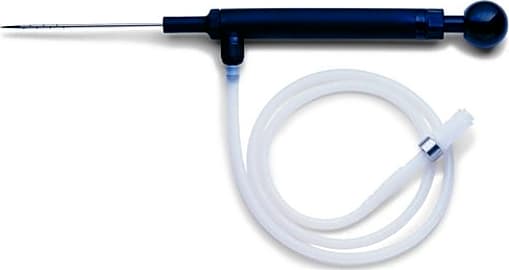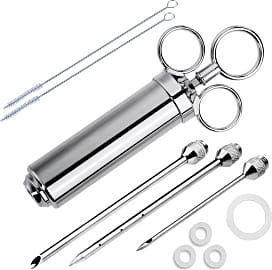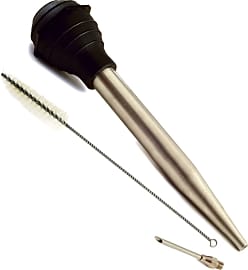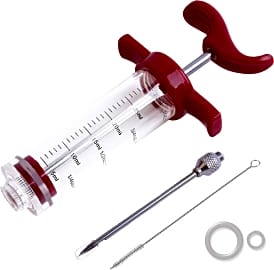The 8 Best Marinade Injectors

This wiki has been updated 43 times since it was first published in June of 2016. If you're interested in upping your grilling game by producing succulent burgers, steaks, and roasted meats, the easiest way is to infuse them with moisture and flavor using one of these marinade injectors. They make it simple to introduce your favorite juices or brines into just about anything, which will ensure mouthwatering, crowd-pleasing meals from the barbecue or your kitchen. When users buy our independently chosen editorial choices, we may earn commissions to help fund the Wiki.
Editor's Notes
July 16, 2021:
We bumped a pair of models that were identical to the JY Outdoor Professional and had poor availability, but the rest of our selections remain the same. The Oxo Good Grips is still our favorite because, like many of Oxo's Good Grips tools, it's easy to use even when your hands are greasy. If you'll be using it a lot, especially on large cuts, though, the SpitJack Magnum is the right choice for you because of its powerful leverage.
May 07, 2020:
Stainless steel marinade injectors are highly useful tools, and we've kept several of them at this time, including the popular Ofargo Stainless Steel and PBKay Seasoning Syringe. These arrive with several needles that ensure you can work with variously sized cuts of meat as well as marinades thick and thin. The GrillHogs BBQ is a popular choice, as well, although it tends to be a bit pricier than the competition. If you want a metal choice, and want to skip the three-ring handle, consider the SpitJack Magnum or the F. Dick Brine, instead. These are more expensive, but they offer a more powerful and comfortable operation, making them a good choice for high volume.
We've also opted to add a couple of plastic models at this time. The Oxo Good Grips is the best of the bunch; it has a clear barrel that doesn't require you to guess how much marinade is left inside, as well as two color-coded needles. There's the TGE-V Syringe, too, although it has half the liquid capacity of the Oxo model. For something a little different, there's the Chef's Planet Flavor Enhancer and the Norpro Deluxe Baster Set. The former is a combination injector and meat tenderizer that boasts two depth settings and is dishwasher safe. The latter is a baster and injector in one package. Unfortunately, it doesn't offer quite the power and versatility of a dedicated marinade injector, but for small tasks, it will get the job done.
Special Honors
Chop's Full Power Injector System It's pricier than manual alternatives, but that's because the Chop's Full Power Injector System is designed to add more marinade, and faster. You can put up to a half a gallon of liquid in its tank, and when you're ready to dispense, its four needles will get the job done in a flash. thekansascitybbqstore.com
Amisy Meat Brine Injector For commercial applications, the Amisy Meat Brine Injector has all the power necessary to tenderize and pickle meats. It's large, of course, and plenty durable, with a stainless steel frame and impeller pump, as well as a sturdy conveyor belt that's built for the long haul. meat-machinery.com
A Brief History Of Marinade
About a century later, the Koreans began to leave beef in a mixture of soy sauce, sugar, garlic, scallions, and sesame oil before preparing it.
When you realize that spices were once among the most valuable commodities in the world, it really makes you think about how terrible food must have been for most of human history. After all, if people are wowed by salt and pepper, imagine how they'll react if you hit them with a little marinade.
The use of marinades likely dates back to the Renaissance, specifically around the 14th century C.E. People would leave their meat and seafood in baths of vinegar and spices, which also preserved the food in addition to flavoring it. They'd even apply the marinade after cooking, as that can keep meat from spoiling for a few hours.
About a century later, the Koreans began to leave beef in a mixture of soy sauce, sugar, garlic, scallions, and sesame oil before preparing it. Meanwhile, in Spain, cooks began experimenting with "escabeche," a sauce made of vinegar.
The origins of the word itself date back to England in the early 17th century. "Marinade" derives from the Latin word, "mare," which refers to the sea. People would leave their dinner soaking in sea water before preparing it, as it was an easy way to salt dishes (again, food was just terrible back then).
Marinades and other sauces became very popular in America a few centuries later. Bottled sauces were commonly sold, as cooking techniques at the time often left meat dry and flavorless. Worcester and Tabasco sauces were extremely popular even before the Civil War, and exist today largely unchanged.
Nowadays, you'll find marinaded meat all over the place, with different cultures having their own spin on sauces. It's one of the easiest ways to take your dinner from bland to spectacular, so if you're not marinating your meat, it's about time you learned.
Benefits Of Injecting Your Marinade
Most people who marinade their meat just do so using the soaking method. This involves submerging your dinner in whatever liquid you're using, and then leaving it in the fridge to seep in over time.
Injecting the marinade, on the other hand, can open your eyes (and taste buds) to a whole new world of flavor. You take the same marinade you'd use to soak your meat in and shoot it directly into the inside of the food, allowing the taste to seep through from the inside.
The main benefit of injecting is that it infuses the flavor throughout the entire cut, rather than concentrating it on the outside.
The main benefit of injecting is that it infuses the flavor throughout the entire cut, rather than concentrating it on the outside. Also, when you soak the meat, it tends to keep the larger spices from getting deep inside, so you're liable to end up with food that's overly salty.
Since it penetrates deep into the tissue, it breaks it down more effectively than soaking would, giving you incredibly tender meat. Tenderizing only occurs when the acids in the sauce come in direct contact with the meat, and jabbing liquid into your beef can certainly facilitate that introduction.
That speeds up the entire process as well. You don't have to leave your ribeye soaking all night long — a few hours should be plenty. You can even do it right before cooking if you're feeling particularly adventurous.
There are downsides, of course. If you're using larger spices, it could clog your injector, and puncturing the meat repeatedly could cause its natural juices to run out while cooking it. It can also lead to flavor pockets if you're not careful about your dispensation.
Of course, if you want to try injecting marinade, but you're not willing to sacrifice a potentially-fantastic steak on the altar of experimentation, you can inject your sirloin and then splash the remaining marinade over it with a baster.
Making The Perfect Marinade
There's no better way to start a fight at a cookout than to suggest you could prepare a steak better than whoever's manning the grill. In fact, in Texas, disparaging a steak is a hanging offense.
So, for us to suggest that we know how to make the perfect marinade carries quite a bit of risk — and yet we soldier on, proving just how confident we are in our recipe.
You can also pair it with a sweetener, such as honey, molasses, or even sugar.
Actually, what we're offering isn't a recipe, per se (our confidence has apparently quickly turned to backtracking). What we're offering are guidelines for making your own marinade, so that you can fine-tune your recipe to your specific tastes.
The first thing you need is a liquid to serve as your foundation. This fluid needs to either be acidic or enzymatic — vinegar, wine, and juice all make fine options. Just be aware that the harsher the liquid, the quicker it will break down your meat, so don't leave it too long. You can also pair it with a sweetener, such as honey, molasses, or even sugar.
Once you have that liquid figured out, you can add herbs, spices, and oils to your mixture. Soy sauce goes well with many acids, and fresh herbs will always liven up your meat.
Feel free to experiment here. Trust your gut and toss things together that just sound like they'd go well together, because chances are, they will. And if they don't, what's the worst that could happen? You have to eat more steak while you experiment?
Once your marinade is ready to go, you can go ahead and inject it directly into your cut of meat, or soak everything in a Ziploc bag if you prefer. Then, prepare it however you like, and be ready to handle all the compliments that come rolling in.


